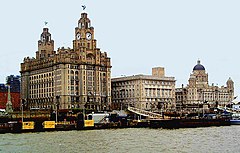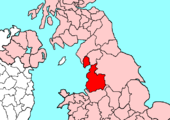Lancashire
| Lancashire United Kingdom | |
 Liverpool from the Mersey | |
|---|---|

| |
| Flag | |
| In consilio consilium (In counsel is wisdom) | |

| |
| [Interactive map] | |
| Area: | 1,880 square miles |
| Population: | 4,942,364 |
| County town: | Lancaster |
| Biggest town: | Manchester |
| County flower: | Red rose [1] |
The County Palatine of Lancaster is a shire along the Irish Sea coast, stretching from the River Mersey in the south to the Furness Fells in the north.
Lancashire is a large and heavily populated county, in population second only to Yorkshire. It runs up the west coast from the Mersey north to Morecambe Bay with a further part north of the sands at Furness.
Lancashire was at the heart of the Industrial Revolution, its cotton mills supplying the Empire and the World. Although competition and changed technology have swept many of the great mills away nevertheless Lancashire is still home to industrial might, and the great towns and cities which grew up in the eighteenth and nineteenth centuries still thrive.
Away from the industrial and urban areas, Lancashire contains scenery of much beauty and jarring contrasts. The Furness district in the north sits on the sea at Barrow-in-Furness, a shipyard and industrial town. Behind Barrow though is a land of lakeland fells, forested and mountainous, forming part of the Lake District. Coniston Water, the west bank of Windermere lie in this part of Lancashire.
In the northern part of Lancashire's main body lies Lancaster itself, a modest county town tumbling charmingly down its hill from the Castle to the Rive Lune. Here the county is fairly narrow, the Pennine Mountains approaching the sea, and the Yorkshire boundary with them.
Between Morecambe Bay and the Ribble Valley, Fylde reaches westward, a broad, flat peninsula whose inland parts are farmland but whose coast is a string of holiday resorts centred on the best known of them all; Blackpool.
Lancashire broadens further south. The coast from the Ribble towards the conurbations of the south has more modest coastal resorts. Inland farmland begins to jostle with industrial towns, the latter becoming bigger and closer together until the great industrial conurbations of south Lancashire. In the southernmost part of the county are Liverpool and Manchester, two of the greatest cities in Britain, whose suburbs spread across not just Lancashire but into Cheshire too.
Liverpool, founded in 1207, was built around its vast docks from the Irish trade then the Atlantic and African trade routes. King John founded his new port at a marshy spot on the Mersey, at the point where the great gulf of the Mersey narrows again into a pinch before entering the Irish Sea. Now though great buildings stand on the waterside, the "Three Graces", and the city has spread all along the Mersey gulf and up the Irish Sea coast.
Manchester, now Britain's most populous city after London, is an older and a younger city; it was a town in Roman days and a fortress borough in Anglo-Saxon times, but it only became a town of national and indeed world significance in the Victorian period, as the heart of the manufacturing revolution. An inland city, its civic arms show a ship and the crest shows the world covered in bees; Manchester's industry reaching the world. The Manchester Ship Canal does indeed link Manchester to the oceans, by way of the Mersey.
| Extreme points of the county | |
| Highest | Old Man of Consiton (2,634 ft) (SD27249783) |
| North | Nab Island, Elter Water (NY335041) |
| South | Hale Head (SJ473809) |
| West | Shope Tree Scar, Walney Island (SD167724) |
| East | White Hill (SD995130) |
Outside links
| Counties of the United Kingdom |
|---|
|
Aberdeen • Anglesey • Angus • Antrim • Argyll • Armagh • Ayr • Banff • Bedford • Berks • Berwick • Brecknock • Buckingham • Bute • Caernarfon • Caithness • Cambridge • Cardigan • Carmarthen • Chester • Clackmannan • Cornwall • Cromarty • Cumberland • Denbigh • Derby • Devon • Dorset • Down • Dumfries • Dunbarton • Durham • East Lothian • Essex • Fermanagh • Fife • Flint • Glamorgan • Gloucester • Hants • Hereford • Hertford • Huntingdon • Inverness • Kent • Kincardine • Kinross • Kirkcudbright • Lanark • Lancaster • Leicester • Lincoln • Londonderry • Merioneth • Middlesex • Midlothian • Monmouth • Montgomery • Moray • Nairn • Norfolk • Northampton • Northumberland • Nottingham • Orkney • Oxford • Peebles • Pembroke • Perth • Radnor • Renfrew • Ross • Roxburgh • Rutland • Selkirk • Shetland • Salop • Somerset • Stafford • Stirling • Suffolk • Surrey • Sussex • Sutherland • Tyrone • Warwick • West Lothian • Westmorland • Wigtown • Wilts • Worcester • York |